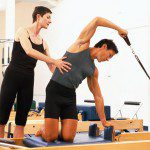It’s no secret that the Pilates method provides a great workout for everyone, yet you hardly ever see any male practitioners of the fitness method. All too often it’s assumed that Pilates is more suited for women, and it’s doesn’t help that the Pilates poster-child usually takes the form of a graceful, beautifully toned female in a leotard and leggings.
Let’s not forget, however, that the person who first developed the system was a man. Joseph Pilates understood that focusing on a strong core — rather than rippling pecs or bulging biceps — was the key to physical strength. The therapeutic benefits of Pilates extend to men as well. Many men suffer from painfully tight muscles in the lower back and hamstrings caused by day-to-day activities: sitting at a desk, mowing the lawn or playing with your kids, for example. When these muscles are tight, it feels like your life becomes just as restricted as your range of motion.
As Joe Pilates himself put it, the Pilates system employs the full range of motion of a healthy human body. By emphasizing core strength and proper spinal alignment, every workout in this classical method addresses the lower back. After a few training sessions, you may be surprised to find that the muscles you’ve been overlooking are really the “manliest” ones in your whole body.



